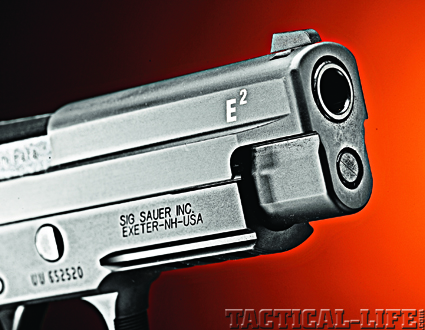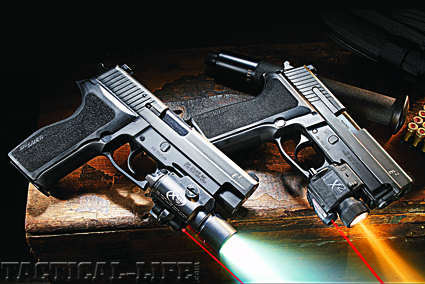New for 2010 are Sig Sauer E2 P226 (left), and P229 (right). The E2 stands for “Enhanced Ergonomics.” The P226 was equipped with a Surefire X400, while the P229 with an Insight Tech-Gear X2L.
I remember when the Sig Sauer double-action pistol, known as the P220, first came to these shores as the Browning BDA (Browning Double Action). The age of the “Wonder 9” was in full swing as a few years earlier Smith & Wesson had introduced the Model 59, a 14-shot DA 9mm, that was making inroads in the revolver-dominated world of US law enforcement. The BDA/P220 originally offered in 9mm, .38 Super and .45 ACP, had the heel-mounted magazine release, which Americans have never been too fond of and its then space-age appearance was not catching on. It also did not have the ammunition capacity people were clamoring for and Browning discontinued the BDA from its product line in the early 1980s due to its poor sales.
The Swiss Industrial Company—Schweize sche Industrie-Gesellschaft (SIG) had by the 1970’s combined with the West German J.P. Sauer & Sohn and looked towards the American market to increase their firearms sales. January 1985 marked the beginning of what was then called SIGARMS in the USA and the then Virginia-based importer offered both the P220 and the P230 compact .380 pistol. In 1987, saw the introduction of one of the most sought after SIG handguns of modern times, the P226. This high capacity, double-column magazine, 9mm had vied for the 1985 US military contract to replace the Model 1911A1. While SIG lost out to Beretta, the P226 did end up as an issue handgun to Navy SEAL Teams, and has since gone on to capture a large share of the US law enforcement market. By 1990 SIGARMS had moved to their present location in Exeter, New Hampshire, and two years later brought out my favorite handgun in the SIG line-up, the .40 caliber P229. As its market-share in firearms increased, the company expanded its civilian product line and SIGARMS Training Academy. Finally on 1 October 2007, the company name was changed to Sig Sauer, which today is an ISO 9001 certified organization with over 380 employees in the US.
Advertisement — Continue Reading Below
Gun Details
 The two new P-series 9mm feature a laser-etched “E2” on the slide. Here’s a good look of the accessory rail on the dustcover for mounting various lights and lasers.
The two new P-series 9mm feature a laser-etched “E2” on the slide. Here’s a good look of the accessory rail on the dustcover for mounting various lights and lasers.
For 2010 Sig Sauer has done an update on the P226 and P229 pistols, and has produced what is being called the E2 version, which stands for “Enhanced Ergonomics.” To my mind it is almost impossible to improve upon what I have always thought of as one of the most ergonomic semi-automatic pistols made—the P226 and its family of pistols, which include the P228 and P229. Few other handguns have ever felt as comfortable in my medium-sized hand—especially the P229, which feels “just right.” Well, I guess Sig Sauer has done the improbable and actually did enhance the feel of the P226 and P229. I was sent test samples of both pistols and hefting them was like taking a trip to handgun “nirvana.”
The two-piece plastic grip panels that once graced the P226 and P229 have been replaced on the P226 E2 and P229 E2 with a one-piece modular grip that reduces the overall grip circumference and lessens the bulk in the backstrap area, making it more adaptable for a wider range of hand sizes. Eliminated along with the separate grip panels are the screws that secured them to the frame; all replaced by the new one-piece grip that snaps into place. A good 80% or more of the grip surface is covered with fine stippling or textured for a very secure, yet comfortable hold, and the frontstrap of the frame is finely serrated. The butt is also made to accommodate a lanyard if so desired. Another thing a person of my hand size appreciates is the E2 models’ reduced reach trigger. I tried one of these on a P229 .40 at the Sig Sauer Academy a few years ago and felt it actually improved my shooting with this pistol. Also, the trigger on current Sig Sauer pistols is greatly improved looks-wise over the old stamped metal part they used to have. Additionally, the E2 trigger incorporates the SRT (Short Reset Trigger) System that provides a 60% reduction in trigger reset, which translates to a more rapid rate of fire.
Advertisement — Continue Reading Below























